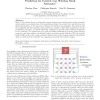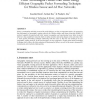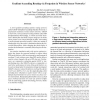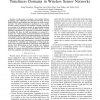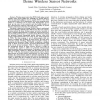100
click to vote
CORR
2011
Springer
14 years 6 months ago
2011
Springer
: Much of the current theory of networked control systems uses simple point-to-point communiodels as an abstraction of the underlying network. As a result, the controller has very ...
116
click to vote
CORR
2010
Springer
14 years 11 months ago
2010
Springer
Energy consumption and delay incurred in packet delivery are the two important metrics for measuring the performance of geographic routing protocols for Wireless Adhoc and Sensor ...
SIGCOMM
2010
ACM
14 years 11 months ago
2010
ACM
RSSI is known to be a fickle indicator of whether a wireless link will work, for many reasons. This greatly complicates operation because it requires testing and adaptation to fin...
104
click to vote
ADHOCNETS
2009
Springer
15 years 1 months ago
2009
Springer
Abstract. As wireless sensor networks gain in popularity, many deployments are posing new challenges due to their diverse topologies and resource constraints. Previous work has sho...
SENSYS
2003
ACM
15 years 4 months ago
2003
ACM
Wireless sensor networks promise fine-grain monitoring in a wide variety of environments. Many of these environments (e.g., indoor environments or habitats) can be harsh for wire...
RTSS
2005
IEEE
15 years 4 months ago
2005
IEEE
A novel gradient-ascending stateless routing protocol, called GRASP (GRadient Ascending Stateless Protocol), is proposed for stationary wireless sensor networks. GRASP is built wi...
125
click to vote
INFOCOM
2005
IEEE
15 years 4 months ago
2005
IEEE
— In this paper, we present a novel packet delivery mechanism called Multi-path and Multi-Speed Routing Protocol (MMSPEED) for probabilistic QoS guarantee in wireless sensor netw...
IPSN
2007
Springer
15 years 5 months ago
2007
Springer
We propose modeling environmental noise in order to efficiently and accurately simulate wireless packet delivery. We measure noise traces in many different environments and propo...
ICCCN
2007
IEEE
15 years 5 months ago
2007
IEEE
—Wireless sensor networks (WSN) built using current Berkeley Mica motes exhibit low reliability for packet delivery. There is anecdotal evidence of poor packet delivery rates fro...
WCNC
2008
IEEE
15 years 5 months ago
2008
IEEE
— A cross-layer algorithm for geographic routing in Wireless Sensor Networks (WSNs) is proposed, which is robust to dead-ends and resilient to topological variations due to netwo...
